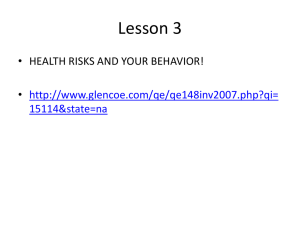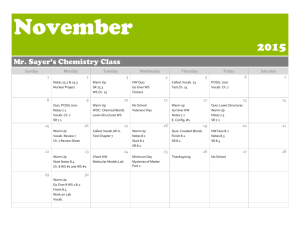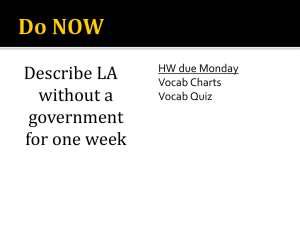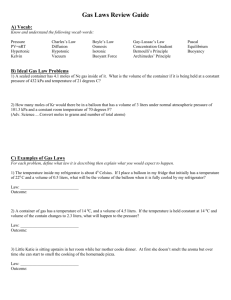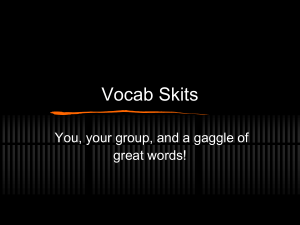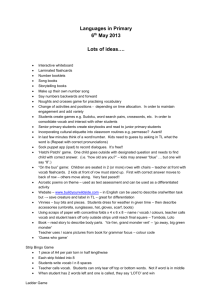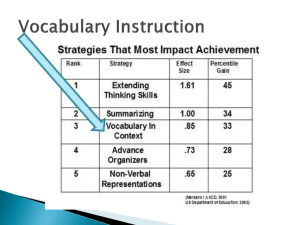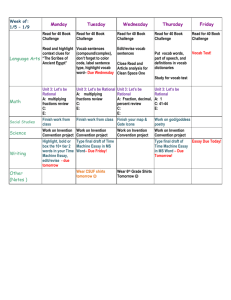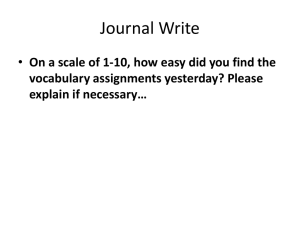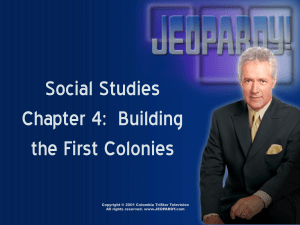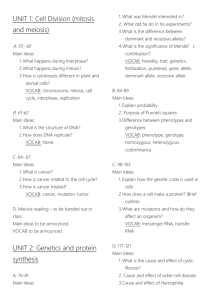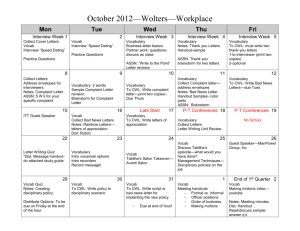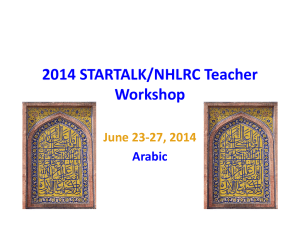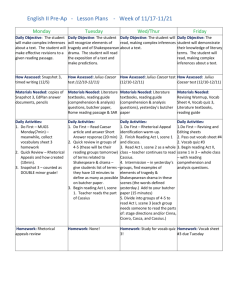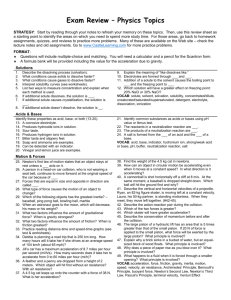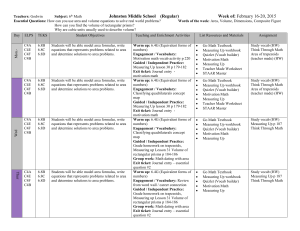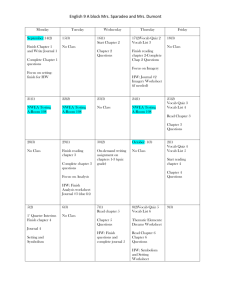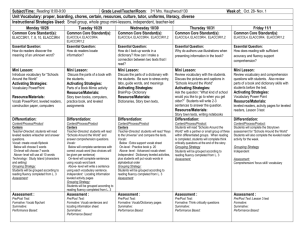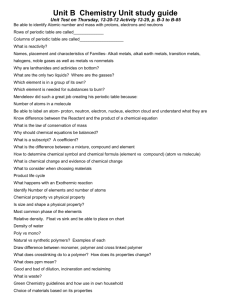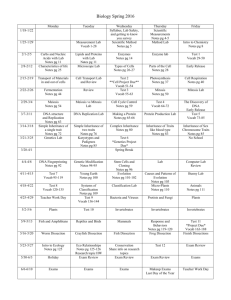Science Vocabulary Words
advertisement
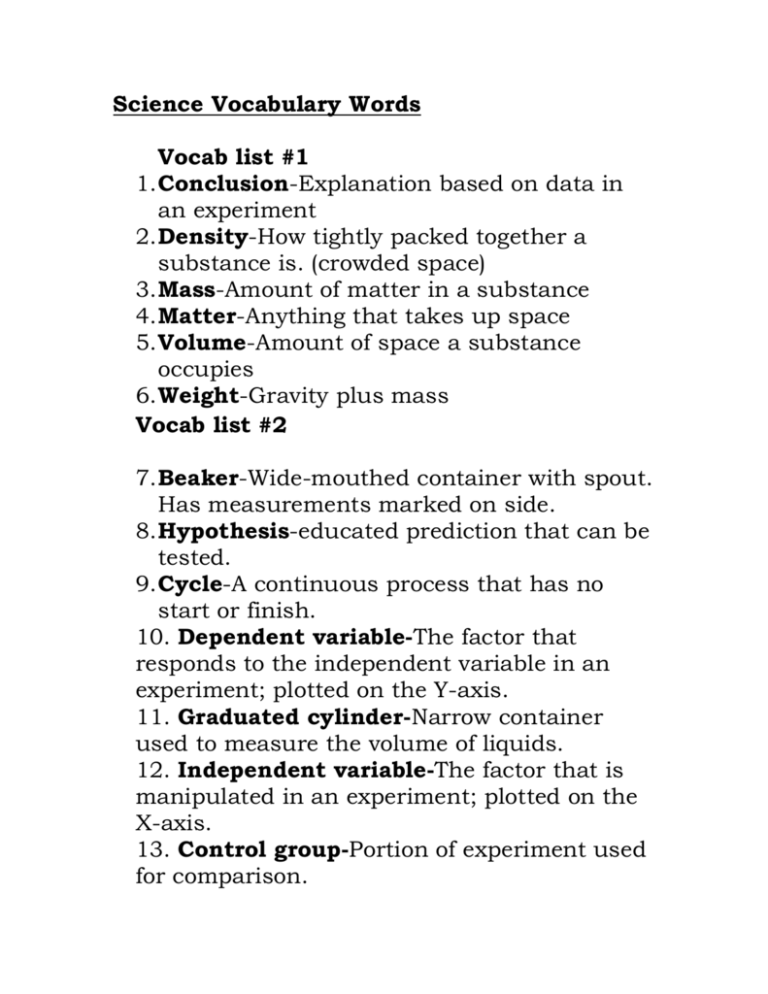
Science Vocabulary Words Vocab list #1 1. Conclusion-Explanation based on data in an experiment 2. Density-How tightly packed together a substance is. (crowded space) 3. Mass-Amount of matter in a substance 4. Matter-Anything that takes up space 5. Volume-Amount of space a substance occupies 6. Weight-Gravity plus mass Vocab list #2 7. Beaker-Wide-mouthed container with spout. Has measurements marked on side. 8. Hypothesis-educated prediction that can be tested. 9. Cycle-A continuous process that has no start or finish. 10. Dependent variable-The factor that responds to the independent variable in an experiment; plotted on the Y-axis. 11. Graduated cylinder-Narrow container used to measure the volume of liquids. 12. Independent variable-The factor that is manipulated in an experiment; plotted on the X-axis. 13. Control group-Portion of experiment used for comparison. 14. Carbon Footprint- A representation of the effect you or the organization has on the climate. 15. Emissions- chemicals or gas that result from burning or combustion. 16. Greenhouse Effect- When heat is trapped in the ozone layer because of too much CO2 in the atmosphere. Vocab #3 list 17. Inference-an explanation of data based on observation 18. Model-a representation that helps to explain something 19. Observation-information gathered from senses 20. Prediction-a guess about what will happen 21. Procedure-step by step process used to conduct an experiment 22. Qualitative-dealing with descriptions 23. Quantitative-dealing with numbers 24. Results-data collected during an experiment 25. Structure-having to do with parts and pieces 26. System-a group of parts that function together Vocabulary List #4 27. Test tube-Narrow container with a rounded bottom used to hold liquids 28. Thermometer-Tool used to measure amount of heat 29. Triple Beam Balance-Tool used to measure mass in grams 30. Isobar- a line on a map connecting points having the same air pressure at the same time. 31. Humidity- the amount of water vapor in the air 32. Psychrometer- tool used to measure relative humidity 33.Weather- The short term state of the atmosphere, including temp., humidity, precipitation, wind and visibility 34. Cloud-a collection of small h2o droplets or ice crystals suspended in the air 35. Meterologist- person who studies atmospheric and weather conditions 36. Air Mass- large body of air where temp. and moisture content are similar throughout. Science Vocab list #5 37. Precipitation-Any form of water that falls to the Earths surface from the clouds. 38. Cumulus-puffy white clouds that tend to have flat bottoms 39. Stratus-clouds that form in layers 40. Cirrus-thin, feathery white clouds found at high altitudes 41. Front-The boundary between air masses of different densities and usually different temperature 42. Thunder-the sound caused by the rapid expansion 43. Lightning-an electric discharge that takes place between two oppositely charged surfaces 44. Hurricane-a severe storm that develops over tropical oceans and whose strong winds of 120km 45. Tornado-a destructive rotating column of air that is very high wind speeds 46. Barometer-an instrument that measures atmospheric pressure Science Vocab List #6 47. Wind-the movement of air caused by differences in air pressure. 48. Anemometer-an instrument used to measure wind speed 49. Cold Front-cold air moves under warm air which is less dense 50. Warm Front-warm air moves over cold air which is less dense 51. Occluded Front-when a warm air mass is caught between two colder air masses 52. Stationary Front-when a cold air mass meets a warm air mass both air masses do not have enough force to lift the warm air mass over the cold 53. Wind vane-an instrument used to measure the wind direction 54. Eye wall-group of cumulonimbus clouds that produce heavy rains and strong winds (around the eye) 55. Eye-center of a hurricane, relatively calm w/low pressure 56. Rain Band-beyond the eye wall, produces heavy rains and high wind Vocabulary list #7. 1. Microscope- Device used to magnify objects too difficult to see with the human eye using multiple lenses at low, medium and high power. 2. Cell Wall- The ridged, porous outer layer of a plant cell. 3. Chloroplast- an organelle that converts the radiant energy of the sun into chemical energy through the process of photosynthesis 4. Cytoplasm- a jelly-like substance, compound mainly of water, occupying most of the space between the cell membrane and the nucleus 5. Endoplasmic reticulum- a network of passageways in which chemical compounds are manufactured, processed, and transported. 6. Golgi apparatus, body, system- a stack of membranes that collects, modifies, and packages chemical compounds. 7. Lysosome- a small sac that contains digestive chemicals 8. Mitochondria- organelles that, using oxygen, converts nutrients into energy that can be used by the cell. 9. Nucleolus- a small body in the nucleus where ribosomes are synthesized. 10. Nucleus- a round body in the center of the cell that contains DNA and directs the cell’s activities. Vocab. #8 List 1.Nuclear Membrane-layer that surrounds the nucleus 2. Cell Membrane-membrane or plasma that surrounds the cell 3. Ribosomes-tiny structure where proteins are synthesized 4. Vacuoles-sac that stores water, nutrients, and other chemicals. Larger in plant cells than animal cells 5. Centrioles-found in animal cells only, organizes movement in cell, moves chromosomes Vocab. #9 List 1. Homeostasis-the maintenance of a constant internal state in a changing environment 2. Tissue-a group of smaller cells that perform a common function 3. Organ-a collection of tissues that carry out a specialized function of the body 4. Skeletal System-the organ system whose primary function is to support and protect the body and to allow the body to move 5. Joint-a place where two or more bones meet 6. Ligaments-strong elastic bands of connective tissue 7. Tendons-connected tissue that attaches muscle to bone 8. Muscle System-the organ system whose primary function is movement and flexibility 9. Skeletal muscle-enables bones to move 10. Cardiac muscle-pumps blood around the body 11. Smooth muscle-moves food through the digestive system Science Vocabulary list #10 1. Integumentary System. The organ system that forms a protective covering on the outside of the body. 2. Epidermis. The surface layer of cells on a plant or animal. 3. Dermis. The layer of skin below the epidermis. 4. Cardiovascular System. A collection of organs that transport blood throughout the body. 5. Heart. Organ made of cardiac muscle that pumps blood through the body. 6. Artery. A blood vessel that carries blood away from the heart to the body’ 7. Capillary. A tiny blood vessel that allows an exchange between blood cells and tissue. 8. Vein. A vessel that carries blood to the heart. 9. Pulmonary Circulation. The flow of blood from the heart to the lungs and back to the heart through the pulmonary arteries,capillaries, and veins. 10. Systemic Circulation. The flow of blood from the heart to all parts of the body and back to the heart.
